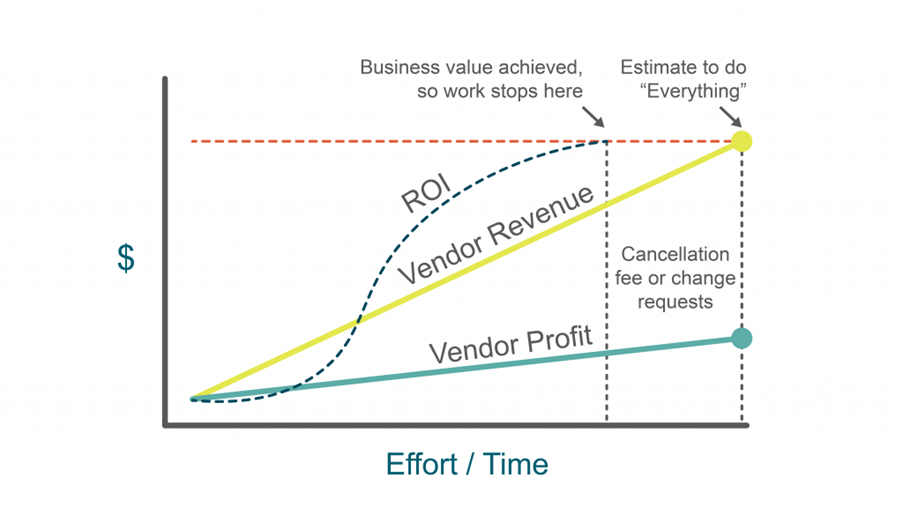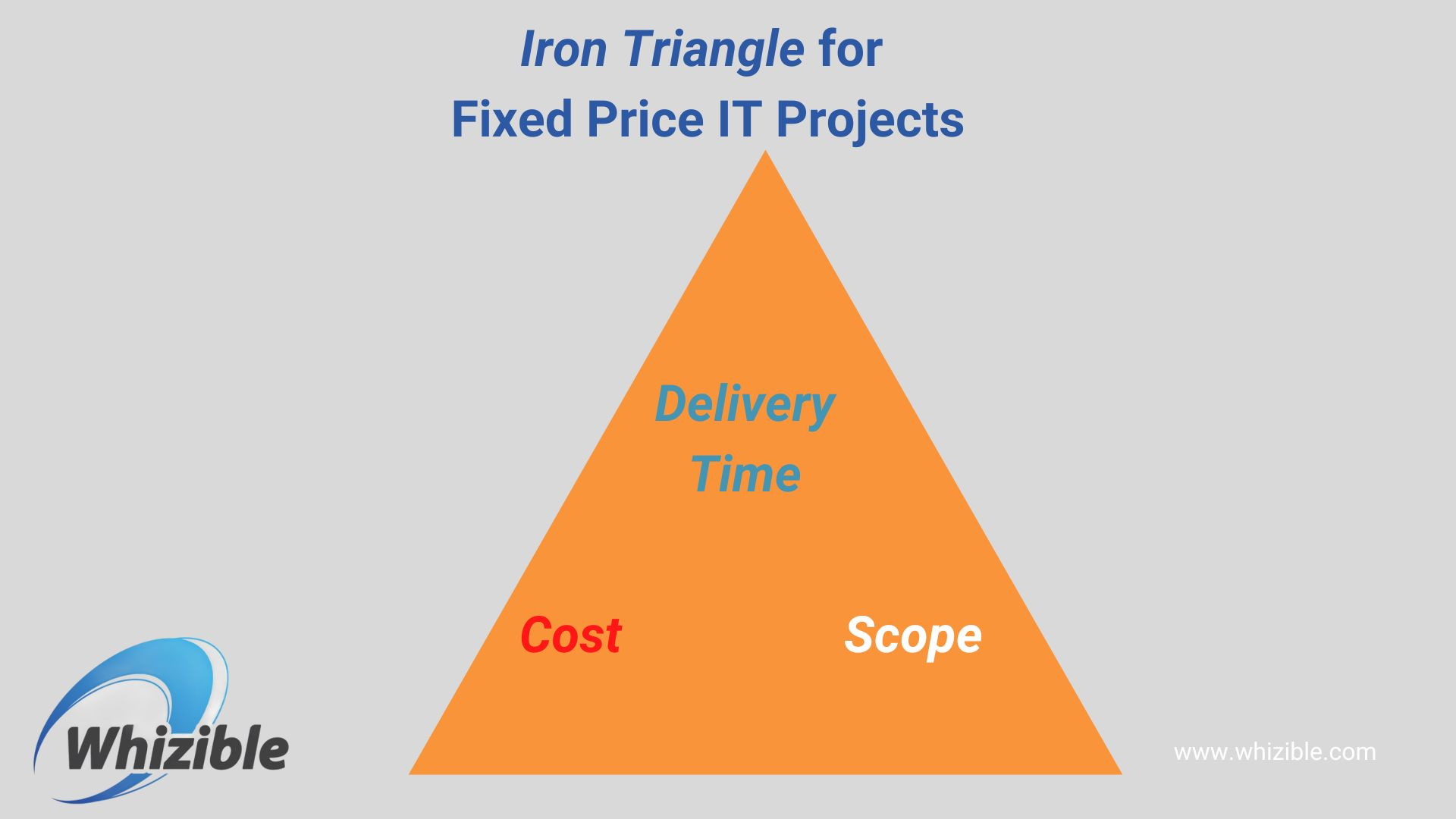Leveraging Agile methodologies for fixed-price or fixed deadline based projects is one of the biggest paradoxes for most organizations; those that are delivering this as a services business or those that are developing these for internal use.. Fixed-bid projects focus on a defined scope and a change management process and involve costs associated with quality delivery within the defined scope. On the other hand, Agile projects are all about the flexibility to make late changes to facilitate the client’s benefit. In a fixed-bid project, there is no variable whether scope, cost, or time, whereas Agile methodologies usually only have time as a constant. Effectively, fixed-price projects help increase profitability by enabling efficient work using optimized resources while Agile is more about enhancing business value and the team’s health.
The most important aspect of executing a project is earning money for the service provider, but the way Agile methodologies work is towards delivering business value – a client “win” which, unfortunately, always looks like an either/or choice. The way forward is a win-win situation that allows both the service provider and the client to win, for which the contract or the purchase arrangement has to go through some changes. The preferred contract may look like the chart below, wherein the service provider (vendor) works at their cost beyond the targeted project completion date.

Harnessing the Agile Methodology for Fixed-price IT projects
At the broader level, the contractually frozen scope, delivery timeline, and cost – the so-called iron triangle – of a fixed-price IT project may seem incongruent with the fluid, change-responsive nature of Agile-amenable projects. Projects undertaken by organizations that leverage Agile tend to involve a series of limited-in-scope deliverables, with the anticipation of scope changes after one or more deliveries. However, any dismissal of Agile’s utility in fixed-price IT projects belies the methodology’s fundamental characteristic as a way of working through change. Equally, even a fixed-price IT project is not entirely change-proof. The client could decide to revisit the project’s scope or the service provider’s resources may become unavailable for unforeseen reasons, for instance. However, clients and service providers can also tweak their contracts to accommodate Agile more extensively.
Purely in terms of the values stated in the Agile manifesto, seeing fixed-price projects as an exchange between people and not simply utilizing resources to create value can bring in an Agile way of working. For example, an emphasis on both the communication within the service provider’s teams and their collaboration with the client is in line with Agile principles. Having a contract in place need not mean that the service provider works in isolation from the client, as they may need some feedback to complete the project successfully. Further, the milestone-oriented structure of a fixed-price IT project invariably means that the client sees a working product at each step, which makes it comparable to an Agile sprint.

Choosing an appropriate Agile methodology – and reaping the benefits
Thinking of Agile methodologies only as approaches for responding to changes overlooks the fact that, while this value is preferred over following a plan, it does not rule out the latter option entirely. Considering that the plan a fixed-price project envisages is not change-proof, adopting an Agile methodology, such as Scrum, can also safeguard the quality of the deliverables from unexpected project changes. Leveraging Scrum, the product owner at the IT service provider’s end – and not the client – can decide the priority in which the deliverables are developed in keeping with the scope spelled out in the contract, with the “must haves” being the first items on the list per the MoSCow principle.
This prioritization allows the service provider to map the project’s scope and size more accurately and also enables allocating resources more efficiently. The immediate consequence on their profitability is obvious, as they can revisit the project scope if needed and, accordingly, re-strategize their resource allocation. Further, suppose the “must haves” are achieved early and the client is assured of value delivery. The service provider can then consider the project nearly successful and execute another strategic pivoting of resources. Factoring in these advantages makes adopting an Agile approach eminently favorable even for fixed-price IT projects.
Consider, for instance, a service provider agreeing to complete a fixed-price project using Agile methodologies, fulfilling whose scope, including development and testing, requires an effort of 12 person months. However, over successive sprints, the project’s scope changes, and the service provider needs to hire more people to complete the project within the agreed-upon deadline. However, they cannot bill this cost to the client given the terms of the fixed-price contract. As a result, the additional resource cost cuts into the service provider’s profit margin.
Whatever the contract mechanism or delivery style, any project’s profitability – for the service provider – is always determined by anticipated work versus actual work executed. Real-time visibility of the planned efforts as well as the efforts undertaken, together with a view of the business value achieved with the contract negotiated as preferred, will surely provide a great entry point for Agile methodologies in fixed-bid projects.
It is easy to see fixed-price IT projects as hidebound endeavors that offer no flexibility beyond contract negotiations. However, service providers and clients can reconfigure project contracts in line with Agile values. In particular, rethinking the constancy of project scope, which is in reality highly subject to change, can help preserve both project quality and the service provider’s profitability. The use of platforms like WhizibleⓇ that offer end-to-end visibility on resource allocation across processes and project stages can reinforce the adoption of Agile methodologies. A careful choice of the preferred Agile methodology can also make a significant difference.
What does it all boil down to?
- A new way of looking at contracts
- Measuring planned vs actual work and their relationship to the business value delivered in real-time
- An integrated framework that enables all of this for Agile methodologies to become frontrunners for fixed-price projects.
References:
- Agile and fixed price projects: How to make it work | Globant Blog
- Constraints on Your Project Still Leave Room to Be Agile (mountaingoatsoftware.com)
- Agile for Fixed Price Contracts (agilebuddha.com)
- Fixed price agile projects (pmi.org)
- Can you deliver a fixed-price project with Scrum? | by Janaka Fernando | Serious Scrum | Medium
- Thoughts about *How Scrum works in fixed-price projects” | Scrum.org


